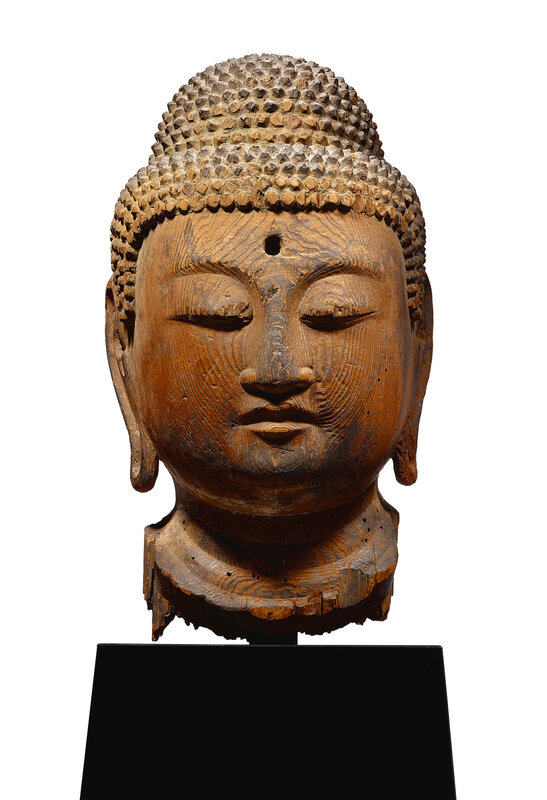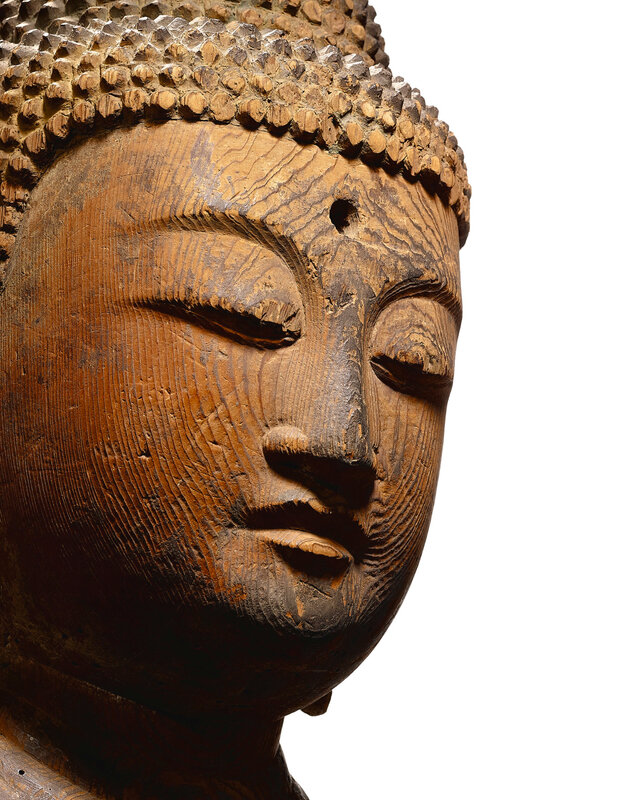A superbly carved wood figure of Amida Nyorai, Japan, late Heian period, 12th century
Lot 3036. A superbly carved wood figure of Amida Nyorai, Japan, late Heian period, 12th century; 37 cm, 14 1/2 in. Estimate 1,200,000 — 1,500,000 HKD (153,480 - 191,850 USD). Lot Sold 1,125,000 HKD. © Sotheby's 2018
sensitively carved in two hollowed sections joined vertically [warihagi zukuri], the rounded face with delicate features portrayed in a meditative expression, gently defined with half open bow-shaped eyes and slit pendulous earlobes, below tightly curled hair covering the domed usnisha, the forehead centred with the urna, the well figured wood bearing a rich reddish brown patina, Japanese wood stand and box.
Note: ang dynasty Buddhist iconography brought to Japan by travelling monks exerted a lasting influence on Japanese sculpture, as exemplified by the present figure dated to the late Heian period (794-1185). Two famous Esoteric priests, Kūkai (774-835) and Saichō (767-822) left Japan for China in the early Heian period (794-1185) and besides religious scriptures brought back many objects of religious significance. Kūkai studied Esoteric Buddhism in the capital, Chang’an, and upon returning to Japan founded the Shingon (Chinese zhenyan, ‘true word’) school of Buddhism there.
However the later part of the Heian period, also designated as Fujiwara, saw an aspiration towards a simpler approach of Buddhism, re-focusing on the central figure of the Buddha of the West, Amida in Japanese, a denomination derived from the Sanskrit Amithaba. In 1175 the monk Hōnen founded the Jodo ‘Pure Land’ school of Buddhism, parting with the complexity of the esoteric Buddhism which was oriented towards the Tibetan tantric pantheon. This evolution also coincides with period of concord in the society after the seizing of the Emperor’s power by the Aristocratic clans in Kyoto, at first the Fujiwara. The calm and serenity portrayed in the present figure is also well representative of this spiritual evolution in the society.
See Sherman E. Lee, A History of Far Eastern Art, London, 1964, pp. 298-299 for further explanations on the political and spiritual evolution in the Japanese society during the later Heian period and its incidence on the arts.
This particular rendering of Amida is traditionally associated with the great ensemble of Buddhist sculptures completed in 1053 by the celebrated late Heian sculptor Jōchō (d. 1057) for the phoenix hall in the Byodo-in in Uji and illustrated in ibid. pp. 304-305.
A similar Buddha's head from the late Heian period, donated by Edward W. Forbes to the Arthur M. Sackler Museum at Harvard University, was included in the exhibition Japanese Art of the Heian Period (794-1185), Harvard University Art Museums, Arthur M. Sackler Museum, Cambridge, 2002, accession no. 1954.140. Compare as well a carved wood sculpture of Amida, dated to the first half of the eleventh century, preserved in the Musée National des Arts Asiatiques, Musée Guimet in Paris, inventory no. MA6144.
Head of a Buddha (Nyoraizô tôbu), Japan, late Heian period, mid 12th century. Wood with traces of polychromy. H. 36 x W. 21 x D. 20 cm (14 3/16 x 8 1/4 x 7 7/8 in.). Harvard Art Museums/Arthur M. Sackler Museum, Gift of Edward W. Forbes, 1954.140 © President and Fellows of Harvard College
Amida assis, Japon, Epoque de Heian, 1e moitié du 11e siècle. Bois avec traces de dorure, 1.4 x 0.98 m. Aacquis mécénat Crédit agricole Indosuez, 1994. Paris, musée Guimet - musée national des Arts asiatiques. Photo © RMN-Grand Palais (MNAAG, Paris) / Michèle Bellot.
See also a late Heian period wood sculpture of Shaka Nyorai, sold at Christie’s New York, 22nd April 2015, lot 9 and another Heian figure of Amida Nyorai, sold at Christie's London, 11th November 2015, lot 68.
A wood figure of Shaka Nyorai (Shakyamuni), Late Heian period (12th century); 23 5/8 in. (60 cm.) high. Estimate USD 35,000 - USD 40,000. Price realised USD 161,000 at Christie’s New York, 22nd April 2015, lot 9. © Christie's Image Ltd 2015
Carved and assembled from cypress wood in warihagi zukuri technique and modeled as the Buddha seated in lotus position with hands in the "concentration" gesture, the hair arranged in small snail-shaped spiral curls (rahotsu), wearing a robe open at the torso and falling in pleats, the body applied with lacquer, inlaid jewels on the forehead and in the hair.
Note: This sculpture depicts the moment at which Shakyamuni achieves his enlightenment at the site of Bodh Gaya in Northeastern India.
A Wood Figure of Seated Amida Nyorai, Heian period (10th century); 78cm. high. Estimate GBP 200,000 - GBP 300,000. Price realised GBP 218,500 at Christie's London, 11th November 2015, lot 68. © Christie's Image Ltd 2015
A sculpture of Nyorai (Amitabha) substantially of the Heian period, of kaya wood, Japanese nutmeg yew, darkened with incense smoke and stained pigmentation, the upper half of torso, face, and head of the Heian period (10th century), and the lower torso a replacement of the Kamakura period (12th-13th century)
Note: The construction of the sculpture is from a single block of kaya wood (Japanese nutmeg yew, as researched by The Royal Botanic Gardens, Kew) which was split down a vertical plane into two main parts which were then partially hollowed out and then joined. This was done in order to relieve stresses occurring over the ages due to the wood drying out which have might led to untoward splitting of the sculpture. The line of this original fissure can be seen running down the sides of the head and through the upper part of the torso. Separate arms, and the sides of the trunk are joined with iron staples forming a hollow interior - a precursor of the later Kamakura period method of yosegi-zukuri in which the whole is composed of an outer shell formed of individually sculpted components.
Carbon dating (RCD-8116 and RCD-8162) indicates that the torso, head and shoulders date from the Heian period (10th century), while the lower part was made during the Kamakura period (12th-13th century).
The figure follows the classic Heian style with a gentle countenance, well-sculpted head coiffure, on the upper part a crystal nikkei symbolising enlightenment, and on the forehead a byakugo (Sanskrit Urna) through which the light of Buddhism is transmitted throughout the world. The hair of some Heian sculptures tends not to be formed in tight curls, but in rounded or truncated pyramidical form like this piece. The fall of the robes is indicative of early period Heian wood sculpture, with the folds over the right shoulder tucked under the robe falling from the left shoulder and across under the right side of the waist, and dropping down a few hand’s breadths to rise again over the right arm then falling away.
The figure might be compared with classic examples of the Tempyo era like the standing Yakushi Nyorai (164.8cm high) in the Kofukujin temple (registered as a National Treasure), and the standing Yakushi figure (169.7cm high) in the Jingoji temple, Kyoto, or the seated Miroku Bosatsu in the Todaiji Nara (39cm high) (registered as an Important Cultural Property).
This style of dress is found also on late Heian sculpture like the standing Amida Nyorai in the Jizoin temple, Kyoto (registered as an Important Cultural Property), but in general the robes of such later Heian period figures sweep across the body and under the right arm with no drapery falling from above so that the right side of the body is exposed.
Sotheby's. Curiosity IV. Hong Kong, 02 Apr 2018, 10:30 AM

/https%3A%2F%2Fprofilepics.canalblog.com%2Fprofilepics%2F1%2F0%2F100183.jpg)
/https%3A%2F%2Fstorage.canalblog.com%2F03%2F02%2F119589%2F96711876_o.jpg)
/https%3A%2F%2Fstorage.canalblog.com%2F11%2F31%2F119589%2F94773502_o.jpg)
/https%3A%2F%2Fstorage.canalblog.com%2F20%2F83%2F119589%2F94772815_o.jpg)
/https%3A%2F%2Fstorage.canalblog.com%2F26%2F72%2F119589%2F75604929_o.jpg)
/https%3A%2F%2Fstorage.canalblog.com%2F59%2F60%2F119589%2F26458628_o.jpg)










/http%3A%2F%2Fstorage.canalblog.com%2F94%2F98%2F119589%2F128936844_o.jpg)
/http%3A%2F%2Fstorage.canalblog.com%2F10%2F21%2F119589%2F128720387_o.jpg)
/http%3A%2F%2Fstorage.canalblog.com%2F66%2F59%2F119589%2F128562333_o.jpg)
/http%3A%2F%2Fstorage.canalblog.com%2F10%2F39%2F119589%2F127811495_o.jpg)